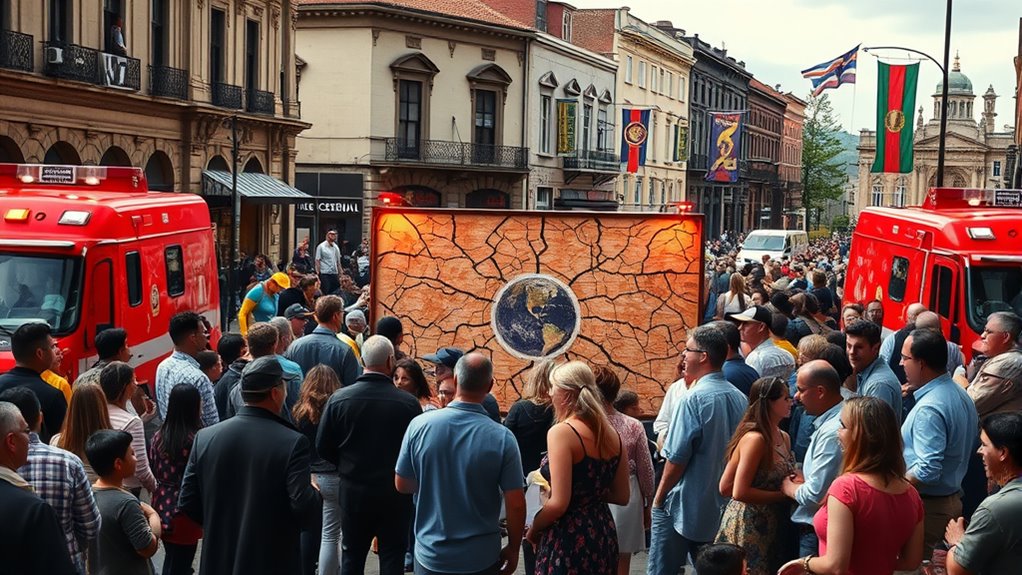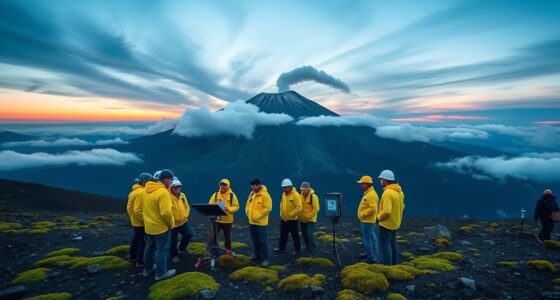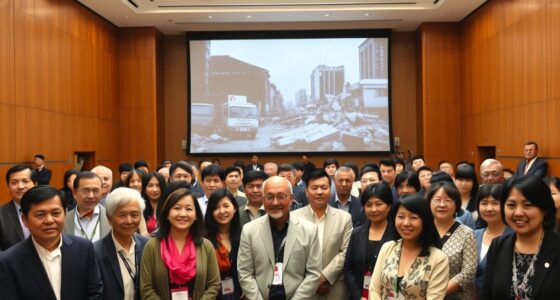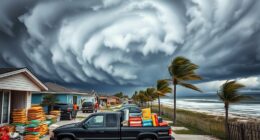The San Francisco Earthquake Centennial is igniting essential safety discussions to boost preparedness for future seismic events. Just as the community rallied after the 1906 disaster, today’s conversations emphasize proactive measures and innovation in building standards. You’ll see how local efforts are shaping the city’s approach to disaster resilience, ensuring that lessons from the past fuel a safer tomorrow. There’s much more to uncover about these initiatives and their impact on the city’s future safety plans.
Key Takeaways
- The centennial of the 1906 earthquake prompted discussions on modern earthquake preparedness and safety measures in San Francisco.
- Commemorative events highlighted the importance of remembering the victims and learning from past disasters.
- Educational initiatives focused on earthquake-resistant construction techniques and updated building codes to enhance safety.
- Local organizations collaborated to promote community resilience and emergency response strategies for future quakes.
- The anniversary served as a reminder of San Francisco’s commitment to innovation and safety in urban planning.
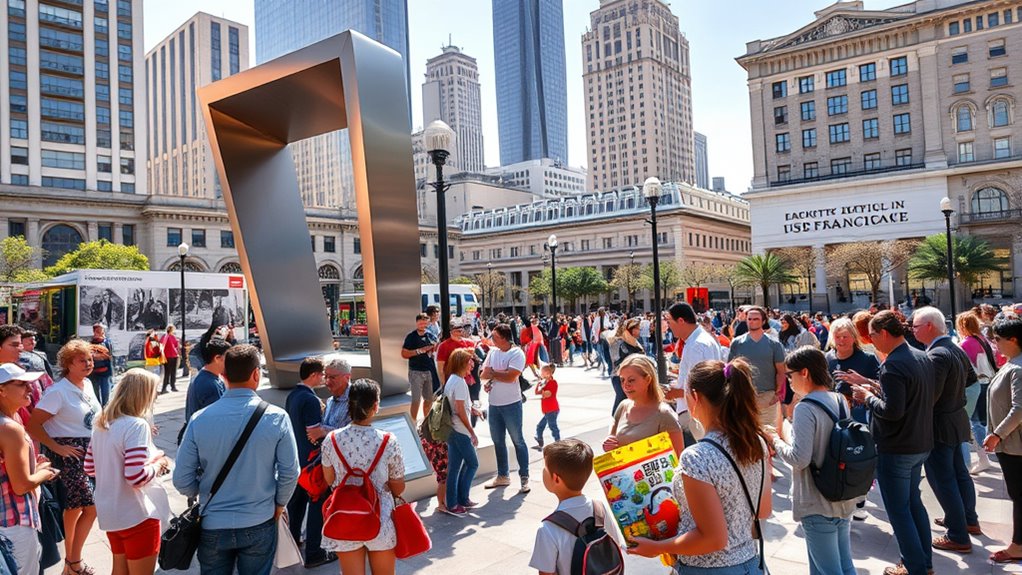
One hundred years ago, on April 18, 1906, the San Francisco earthquake struck at 5:12 AM, forever altering the landscape and history of the city. With a staggering magnitude of 7.9, it originated near the San Andreas Fault and released devastation that would haunt the city for decades. Over 80% of San Francisco lay in ruins, not just from the quake but from the raging fires that followed for days. The estimated death toll ranges from 700 to over 3,000, making it the deadliest earthquake in U.S. history.
As you reflect on this tragic event, consider how it transformed the city’s infrastructure. Thousands of buildings were destroyed, vital services were disrupted, and the city faced an urgent need to rebuild. This catastrophe prompted significant changes in building codes and safety regulations, ensuring that future structures would withstand seismic activity. The disaster didn’t just end in destruction; it spurred innovation in earthquake-resistant construction techniques, paving the way for safer urban environments.
The humanitarian response to the earthquake was remarkable. Relief efforts poured in from across the nation and around the world, showcasing the resilience and compassion of communities. The U.S. military played an essential role in delivering aid and restoring order, while local residents rallied to support their displaced neighbors. Recovery took years, but it laid the groundwork for a stronger, more unified city.
Looking at the economic impact, the rebuilding efforts stimulated local economies, creating new businesses and industries. San Francisco emerged as a hub for various sectors, fueled by heavy investment in infrastructure upgrades. The earthquake not only reshaped the skyline but also sparked a wave of innovation in construction and urban planning. You can see the city’s growth as a reflection of its ability to rise from the ashes.
As the centennial of the earthquake approaches, the focus shifts to safety talks and educational initiatives aimed at increasing public awareness. Commemorative events will honor those who lost their lives while emphasizing the importance of preparedness for future quakes. Efforts to preserve historical sites affected by the disaster also remind you of the city’s resilience and the lessons learned over the past century.
In embracing the legacy of the 1906 earthquake, you become part of a shared commitment to safety and innovation that continues to shape San Francisco today.
Frequently Asked Questions
What Are the Different Types of Earthquakes?
There are several types of earthquakes you should know about.
Tectonic earthquakes happen due to plate movements, while volcanic earthquakes are caused by volcanic activity.
You’ll encounter collapse earthquakes from underground voids and induced earthquakes from human activities.
Based on depth, they can be shallow or deep-focus.
Magnitude classifications range from microseismic to major.
Additionally, earthquakes are categorized by location, such as local or distant, and their impact, like felt or destructive.
How Can I Prepare My Home for an Earthquake?
To prepare your home for an earthquake, start by securing heavy furniture and appliances with brackets and straps.
Relocate heavy objects off high shelves and install latches on cabinets to prevent spills.
Identify safe spots in each room and practice “Drop, Cover, and Hold On” drills with your family.
Stockpile emergency supplies, including food and water, and guarantee clear exit paths.
Finally, consider retrofitting your home to enhance structural safety.
What Is the Richter Scale?
Think of the Richter Scale as a helpful friend measuring the strength of earthquakes.
It’s a logarithmic scale created by Charles F. Richter in 1935, where each whole number jump represents a tenfold increase in wave amplitude.
So, if you experience a magnitude increase, that means about 31 times more energy’s been released!
It’s widely used to report earthquakes globally, giving you a clearer picture of nature’s powerful forces.
How Do Emergency Services Respond During an Earthquake?
During an earthquake, emergency services quickly mobilize to respond to distress calls and assess damage.
You’ll see rescue teams deployed, working tirelessly to reach those trapped. Communication networks are prioritized to guarantee coordination. Utility management is vital to prevent hazards like gas leaks.
They monitor for aftershocks and issue public safety alerts to keep you informed. Through effective planning and training, emergency responders aim to secure your safety and expedite recovery efforts.
What Should I Include in an Emergency Kit?
When you’re putting together an emergency kit, make sure to include essentials like water, non-perishable food, and a first aid kit.
Don’t forget manual tools, flashlights with extra batteries, and a radio for updates.
Pack personal hygiene items, sleeping bags, and a change of clothes for comfort.
Also, include important documents, cash, pet supplies, and a list of your health information.
Being prepared can make all the difference in an emergency.
Conclusion
As you reflect on the San Francisco Earthquake Centennial, it’s fascinating how this moment in history coincides with today’s heightened focus on safety and preparedness. Just as the city learned from past tremors, you too can take steps to guarantee your own safety. So, whether you’re securing your home or participating in community discussions, remember that each small action contributes to a larger legacy of resilience. Who knows? Your efforts might even inspire someone else to take safety seriously.

